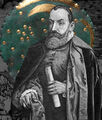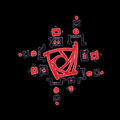Template:Selected anniversaries/May 12: Difference between revisions
No edit summary |
No edit summary |
||
| Line 29: | Line 29: | ||
||1870: Eduard Ritter von Weber born ... mathematician. He will work with partial differential equations, in particular the Pfaff problem. Pic. | ||1870: Eduard Ritter von Weber born ... mathematician. He will work with partial differential equations, in particular the Pfaff problem. Pic. | ||
||1874: Clemens von Pirquet born ... physician and immunologist. He noticed that patients who had previously received injections of horse serum or smallpox vaccine had quicker, more severe reactions to a second injection. He, along with Béla Schick, coined the word ''allergy'' to describe this hypersensitivity reaction. Pic. | |||
||1895: William Giauque born ... chemist and academic, Nobel Prize laureate. Pic. | ||1895: William Giauque born ... chemist and academic, Nobel Prize laureate. Pic. | ||
| Line 40: | Line 42: | ||
File:Stanisław Leśniewski.jpg|link=Stanisław Leśniewski (nonfiction)|1907: Mathematician, logician, and crime-fighter [[Stanisław Leśniewski (nonfiction)|Stanisław Leśniewski]] publishes his philosophy of three nested formal systems and their application to detecting and preventing [[crimes against mathematical constants]]. | File:Stanisław Leśniewski.jpg|link=Stanisław Leśniewski (nonfiction)|1907: Mathematician, logician, and crime-fighter [[Stanisław Leśniewski (nonfiction)|Stanisław Leśniewski]] publishes his philosophy of three nested formal systems and their application to detecting and preventing [[crimes against mathematical constants]]. | ||
||1910: Dorothy Hodgkin born ... biochemist, crystallographer, and academic, Nobel Prize laureate. | ||1910: Dorothy Hodgkin born ... biochemist, crystallographer, and academic, Nobel Prize laureate. Pic. | ||
||1915: Tony Strobl born ... comics artist and animator. Link search yes: https://www.google.com/search?q=tony+strobl | ||1915: Tony Strobl born ... comics artist and animator. Link search yes: https://www.google.com/search?q=tony+strobl | ||
Revision as of 18:12, 10 May 2019
1812: Artist, musician, author, and poet Edward Lear born either today or tomorrow.
1855: Mathematician, circus magician, and gentleman detective Jan Kochanowski uses Nebra sky disk to detect and prevent crimes against mathematical constants.
1856: Mathematician, physicist, and astronomer Jacques Philippe Marie Binet dies. He made significant contributions to number theory, and the mathematical foundations of matrix algebra.
1857: Mathematician Oskar Bolza born. He will be known for his research in the calculus of variations; his work on variations for an integral problem involving inequalities will later became important in control theory.
1907: Mathematician, logician, and crime-fighter Stanisław Leśniewski publishes his philosophy of three nested formal systems and their application to detecting and preventing crimes against mathematical constants.
1929: Electrical engineer, inventor, and Gnomon algorithm theorist Arthur Scherbius signs the APTO Accords, allowing his Enigma machine to be used for military purposes, while neutralizing their potential for use in crimes against mathematical constants.
1941: Engineer, inventor, and pioneering computer scientist Konrad Zuse presents the Z3, the world's first working programmable, fully automatic computer, in Berlin.
2014: Painter, sculptor, and set designer H. R. Giger dies. He gained fame for his work on the film Alien.
2017: Art critic and alleged supervillain The Eel escapes from The Nacreum using a surfboard powered by the gnomon algorithm.
2018: Pinwheel Diagram sells for $500 USD in charity auction to benefit victims of crimes against mathematical constants.









